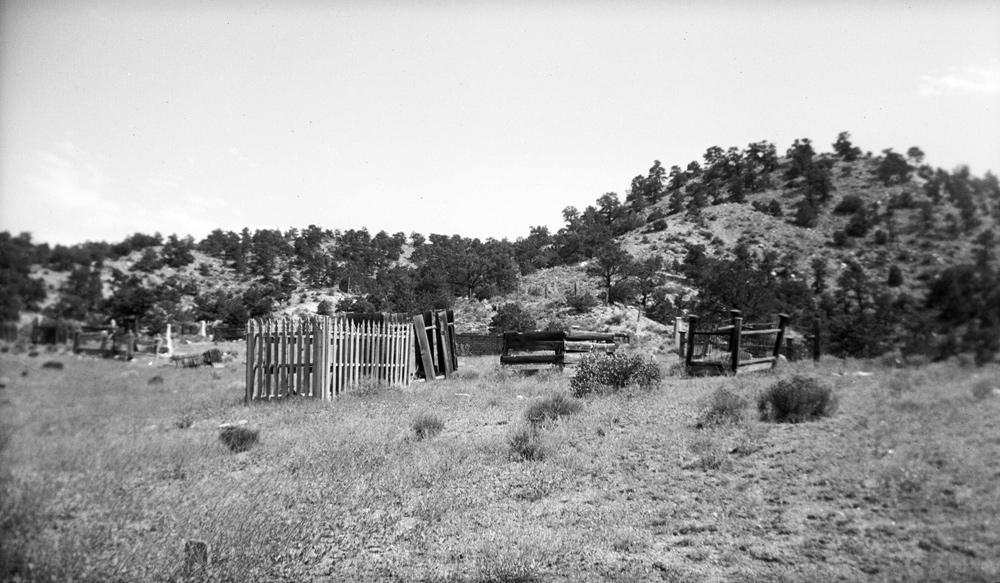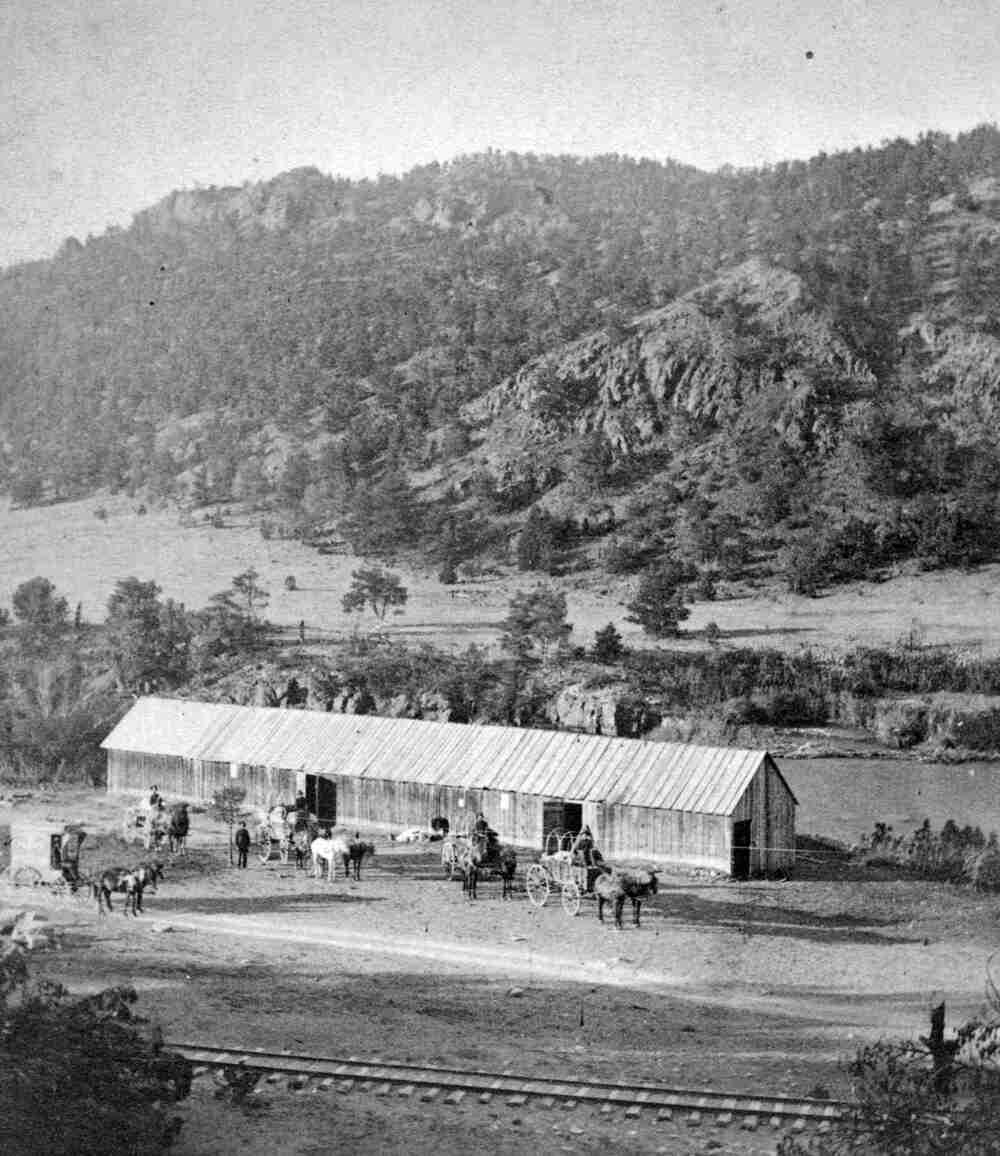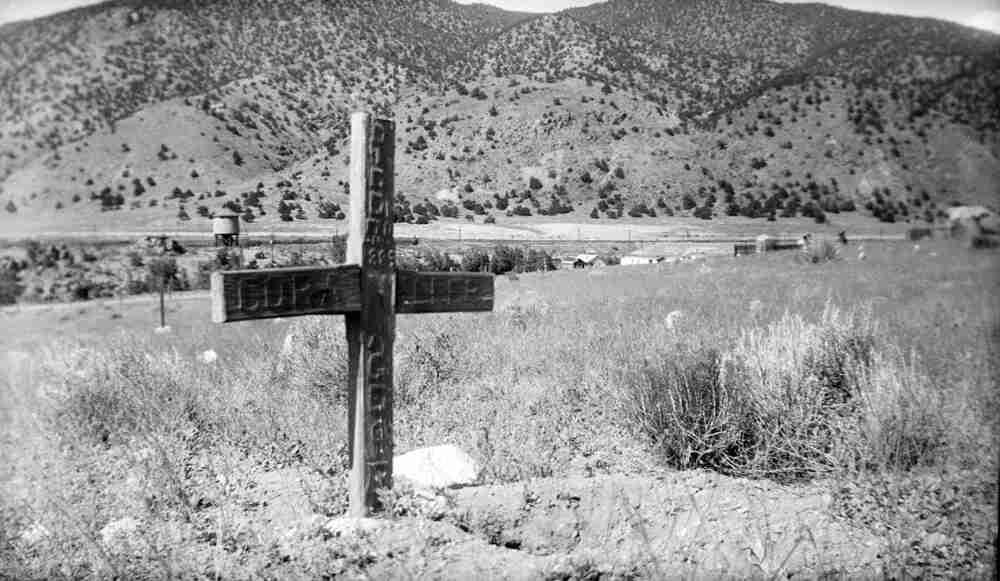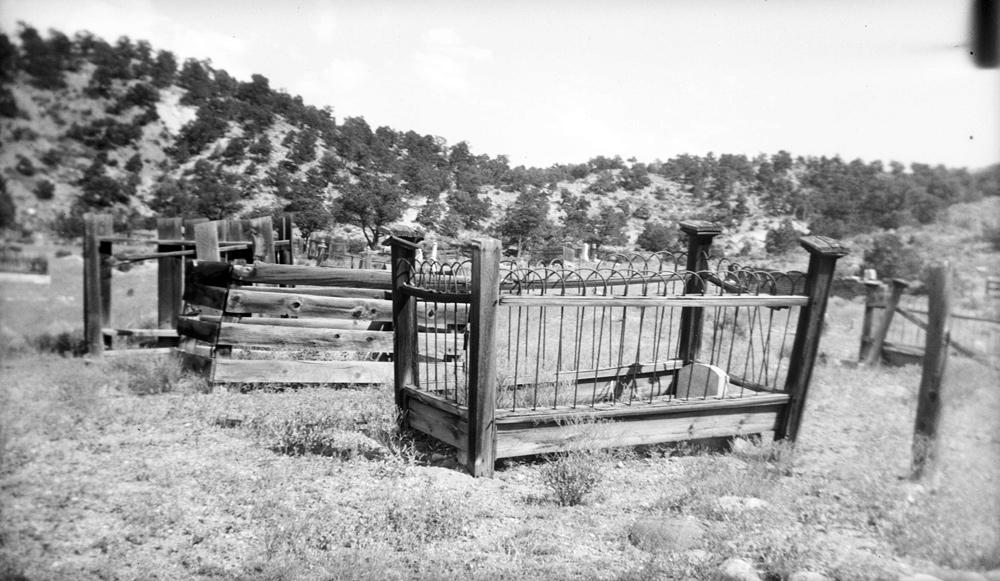Cleora Cemetery
Full Article
Cleora Cemetery is a historic four-and-a-half-acre burial ground located on a hill south of the Arkansas River about two miles southeast of downtown Salida. Originally associated with the short-lived town of Cleora, the cemetery received its first burials around 1880 and was the only cemetery in the area for the rest of that decade, making it the final resting place for many early settlers. Regular burials continued until about 1910, followed by less frequent interments until 1948. Today the cemetery, which has five historic wood grave markers and at least 200 burials, is still maintained by relatives of the deceased.
Cleora’s Brief History
Cleora Cemetery originally served the town of Cleora, which took shape near William Bale’s ranch and stage stop about a mile south of where the South Arkansas River meets the Arkansas River. In the 1860s, Bale had tried his hand at prospecting in California Gulch and farming near what is now Buena Vista before establishing his ranch along the Arkansas River by the end of the decade.
Taking advantage of their favorable location near roads heading in all directions, Bale, his wife, and their daughter Cleora soon started operating a stage stop where travelers could get a stiff drink and stay overnight. In the early 1870s, Bale’s Tavern, as it was known, filled with prospectors heading to the San Juan Mountains or the Gunnison area. An important and well-known social center, the tavern served as a meeting spot for vigilantes during the Lake County War of 1874–75, a period of murder and property destruction among early settlers in the Upper Arkansas Valley. After the violence calmed down, a post office opened at Bale’s in December 1876. William Bale served as postmaster, and the office was named Cleora after his daughter.
The silver boom at Leadville in the late 1870s sparked an increase in traffic at Bale’s Tavern as well as a battle between the Denver & Rio Grande (D&RG) and Atchison, Topeka & Santa Fe (AT&SF) Railroads over the route through the Royal Gorge to the Upper Arkansas Valley. In 1878 investors associated with the AT&SF bought land from Bale and laid out the town of Cleora near his ranch, where they assumed the railroad would establish a division point for a spur line going up the South Arkansas River. Over the next two years, the town experienced a brief boom on the strength of hopes and speculations, attracting several hundred residents and a variety of businesses. A newspaper, the Cleora Journal, published its first issue in June 1879, and the town incorporated two months later.
But the town of Cleora’s hopes had raced ahead of reality. In March 1880 the so-called Treaty of Boston resolved the railroad dispute in favor of the D&RG, which had no interest in helping a town affiliated with its rival. The D&RG bypassed Cleora and established its own town called South Arkansas (later Salida) about a mile and a half to the north. To drive the final nail in Cleora’s coffin, the D&RG offered free lots to anyone from Cleora who moved a house or building to the new town. Soon Salida boasted a post office, a newspaper, and more than 1,000 residents, while Cleora emptied out and lost its post office in 1882.
In 1903 the D&RG established a large stockyard at the former site of Cleora, which is now home to Rocky Mountain Livestock Sales. No original town buildings have survived, leaving Cleora’s cemetery as the town’s only remnant.
Local Cemetery Lives On
By 1880 at the latest, Cleora had an informal cemetery on the side of a small hill south of town. Like many so-called boot hill cemeteries in the frontier West, Cleora Cemetery was established with almost no planning. Locals simply seized the nearest unclaimed hillside and started burying people there without bothering with formal landscaping, established paths, or designated gravesites. Worthless for farming because of its slope, the cemetery plot remained part of the public domain until the 1890s.
It is possible that the first burial at Cleora took place as early as 1875, when Charles Harding was killed near Bale’s Tavern during the Lake County War. If Harding was not buried on the hill above where he was killed, then burials were almost certainly taking place there by 1880, when Matilda Hawkins, Cleora mayor’s twenty-two-year-old daughter, died. (In 1987 locals recorded the presence of a marker dated 1880, but it is no longer standing.) Soon the cemetery became well known and well used. Despite the decline of Cleora and the rise of Salida in the early 1880s, Cleora Cemetery continued to be used for most burials in the area because Salida did not have its own cemetery until the end of the decade.
As a boot hill cemetery, Cleora had no formal plan for burial sites and therefore no discernable segregation based on ethnicity, class, or religion. Graves were placed haphazardly around the cemetery wherever families found a spot they liked. As a result, the cemetery’s dry north end received few burials, while the higher south end was favored for gravesites because it had a few trees and was farther from the road. Some graves went unmarked. Most had simple markers or enclosures made of wood, wrought iron, or stone.
By the end of the 1880s, Cleora’s distance from Salida and the cemetery’s lack of landscaping or any formal grave layout led Salida residents to push for a new cemetery that would be closer and prettier. But even after Salida opened its first two cemeteries, in 1889 and 1891, Cleora Cemetery continued to see frequent burials and host Memorial Day activities and grave-decoration services put on by groups such as the Grand Army of the Republic, Knights of Pythias, and Woodmen of the World.
Today
Cleora Cemetery occupied land that remained part of the public domain until 1894, when James White bought a parcel that included the small cemetery. White allowed burials to continue under his ownership, as did Peter Veltrie, who bought the land in 1898. When Veltrie sold the land to Chaffee County for $75 in 1921, he included a provision that the cemetery should continue to be used as a free burial ground.
Burials at Cleora dropped off after 1910, as locals shifted to using Salida’s more convenient and better-maintained cemeteries. Nevertheless, a few interments continued to take place at Cleora each year until 1948, when Phillip Englebright was laid to rest beside his wife, Carrie, herself a 1936 burial; the couple had lived in the area since at least 1885. After that, Chaffee County declared an end to burials at Cleora Cemetery because officials had no record of prior grave locations and did not want to accidentally disturb any of them.
Since Cleora Cemetery stopped being used for burials, it has been maintained primarily by the family members of the people interred there. The cemetery experienced some problems with vandalism in the 1970s and early 1980s, but in 1983–84 Dennis Morain, Wesley Cooper, and Scott Glenn led an effort to clean the site and restore grave markers that had been knocked down. Today five original wood grave markers still stand along with a variety of historic metal and stone markers, and the cemetery probably contains at least 200 burials. It is accessible via a short gravel road south of US 50 and is enclosed by a barbed-wire fence. In 2017 it was listed in the National Register of Historic Places.








